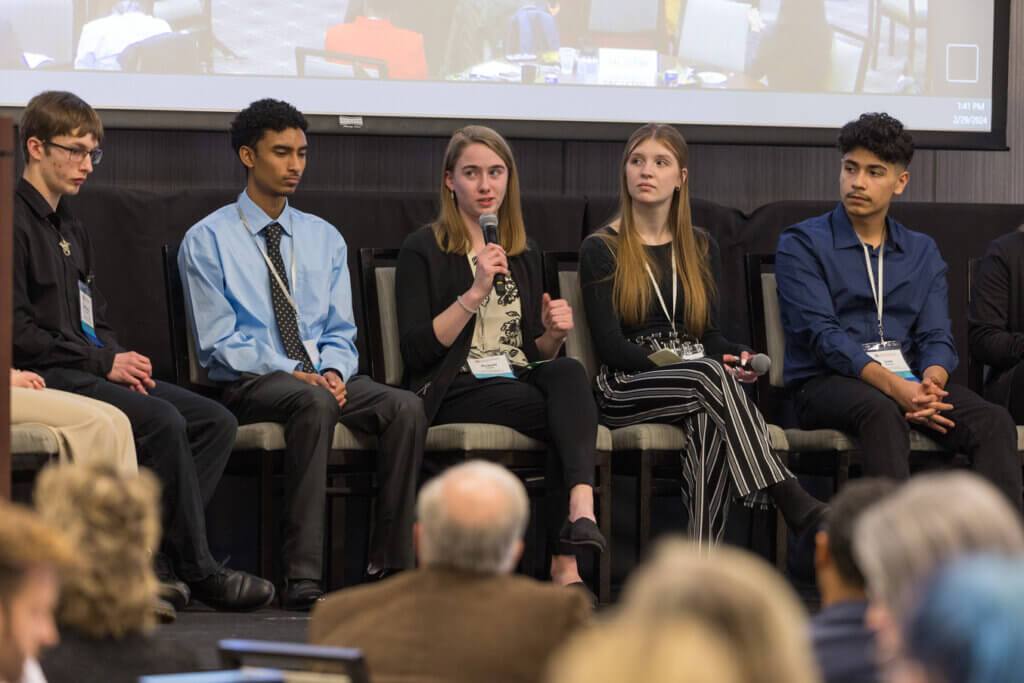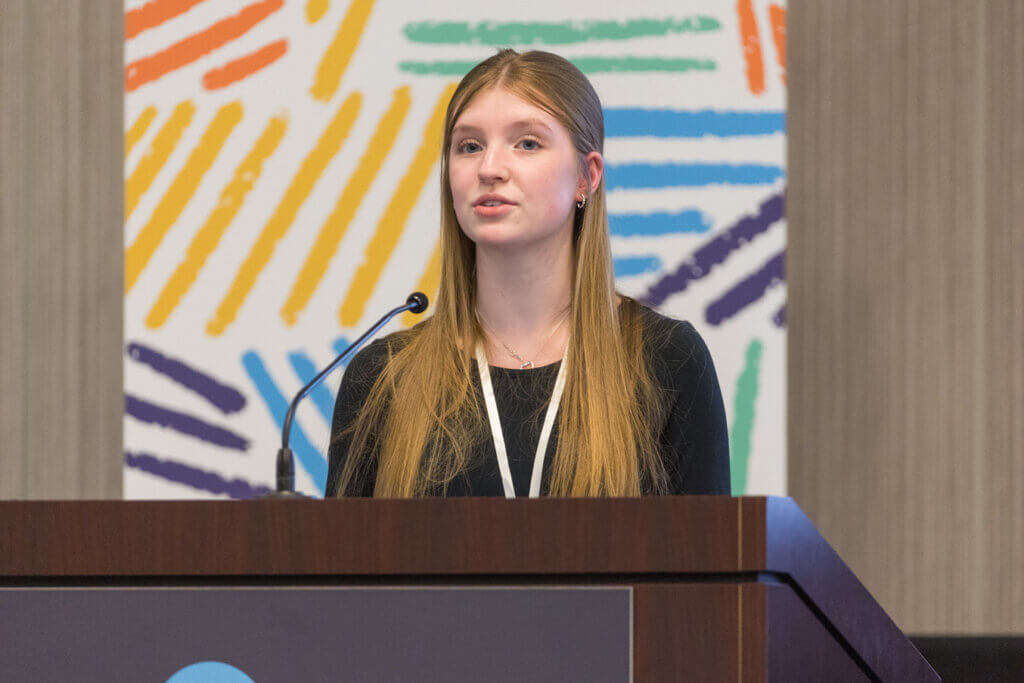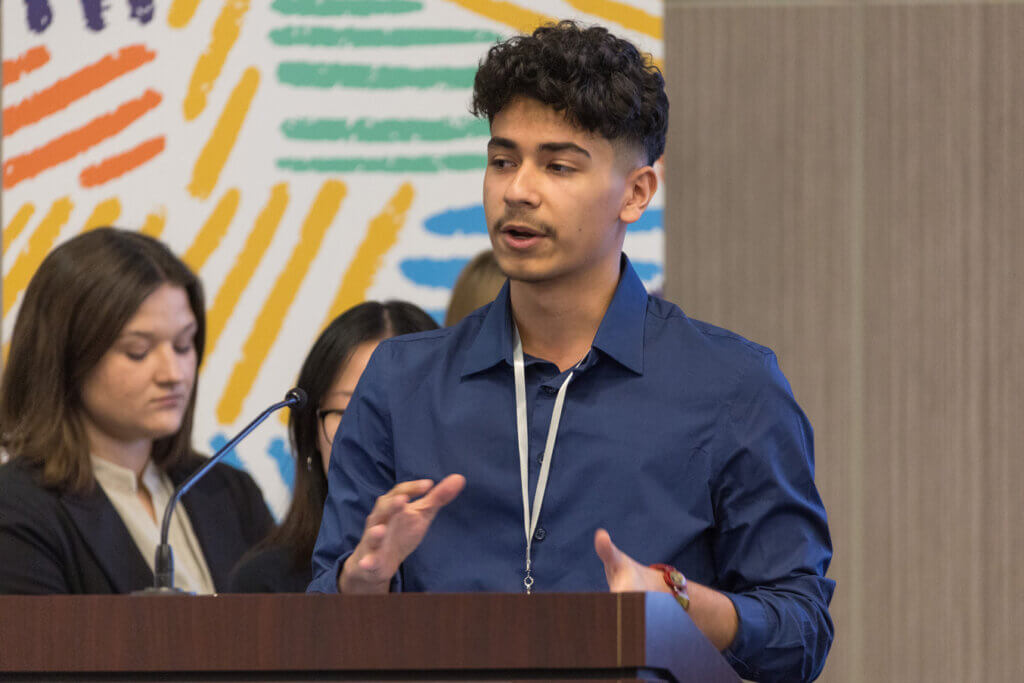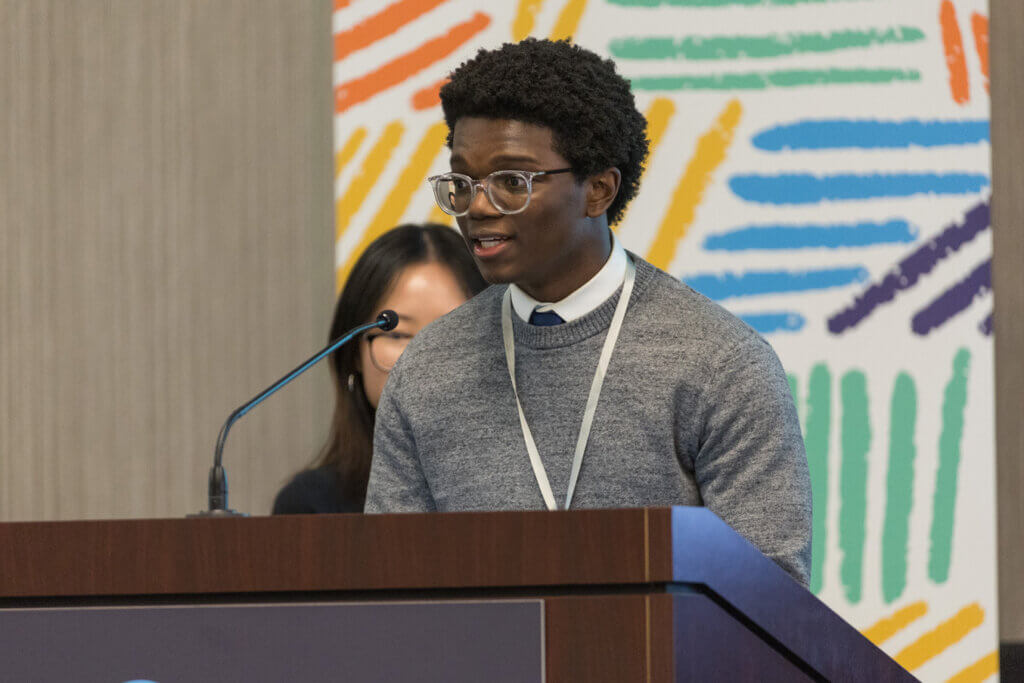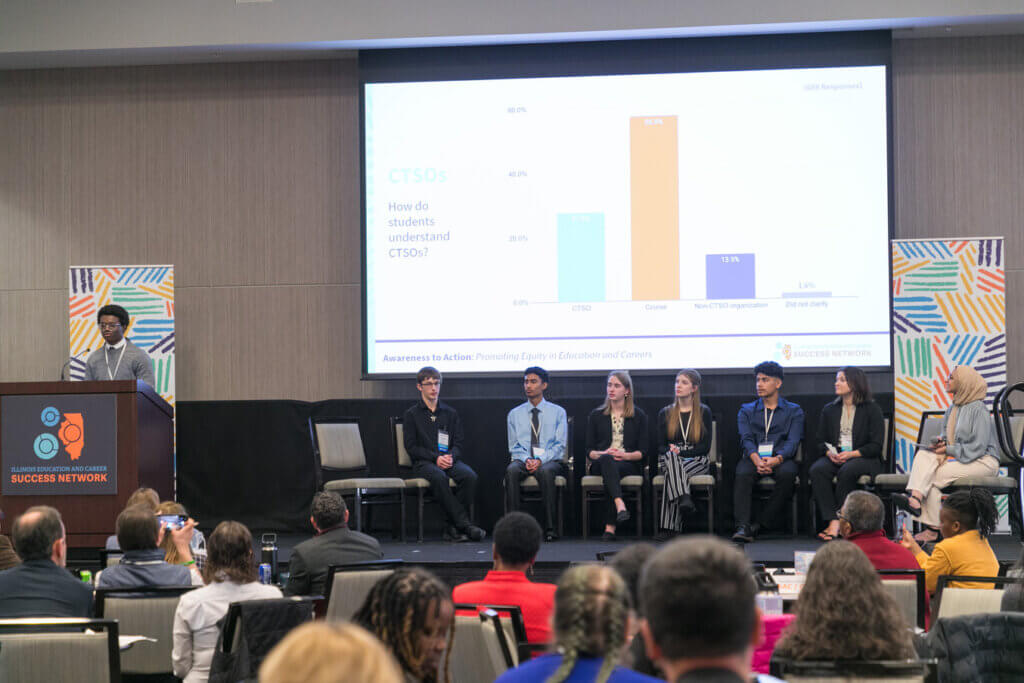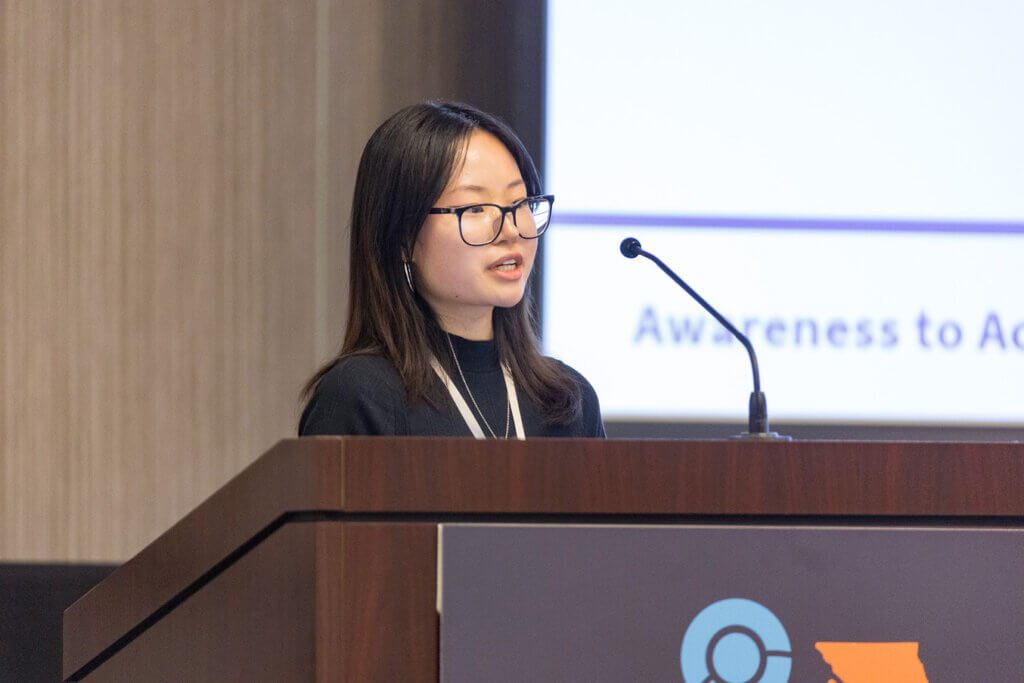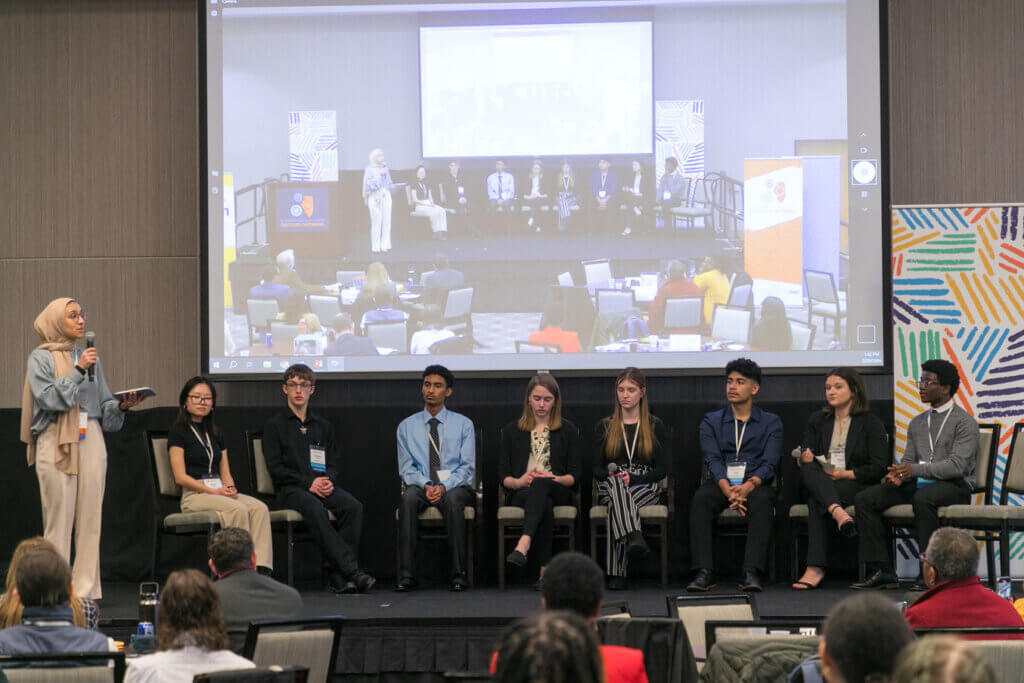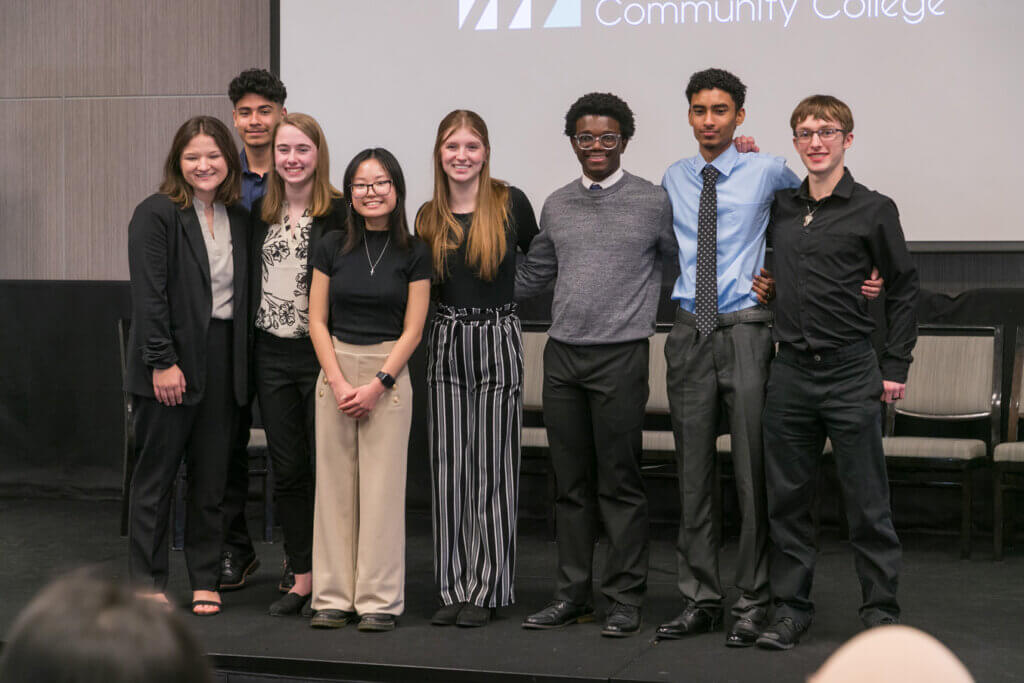In an inspiring plenary session at the Illinois Education and Career Success Network Annual Conference, members of the Success Network Student Advisory Council (SAC) and the Career and Technical Student Organization (CTSO) Student Board showcased research on dual credit and career and technical education courses statewide and offered recommendations for addressing barriers.
The student leaders analyzed data from a survey conducted by the National Alliance for Partnerships in Equity and the Illinois State Board of Education that aimed to capture the current landscape of dual credit and Career and Technical Education (CTE) courses in Illinois and identify barriers to their access. The survey received responses from more than 7,000 students across the state. The analysis was conducted in collaboration with CTE and Innovation Director Marci Johnson at the Illinois State Board of Education, who also oversees the CTSO student board.
An essential tenet of this work was for the students involved to develop research and communication skills that will serve them beyond this project while simultaneously contributing to research in hopes of benefiting their peers.
“I learned how to interpret the data in spreadsheets and also how to make these into graphs, and aside from that learned about what barriers that students were facing and how they were different from my school. My school doesn’t have to worry so much because we are such a small school. We have transportation, class enrollment, and schedules covered, but I realized that other schools had these problems that I was never aware of.”
Jose Vences, Junior, North Chicago Community High School, when asked what he learned from the process of looking at dual credit and career and technical education classes through this project.
The student leaders who volunteered to take part in the research team are:
- Massillon Boyd, Junior, West Aurora High School (CTSO Board)
- Madyson Carlyle, Senior, Collinsville High School (CTSO Board)
- Nicole Griffith, Senior, Fulton High School (Success Network SAC)
- Anthony Kelson, Junior, Mendota Township High School (Success Network SAC)
- Jahnavi Kolli, Senior, Warren Township High School (CTSO Board)
- Samuel Matura, Junior, Mendota Township High School (Success Network SAC)
- Trinity Muszynski, Senior, Lockport Township High School (CTSO Board)
- Pragati Shree Sasikumar Sophomore, Normal Community High School (Success Network SAC)
- Rowan Smith, Junior, Moline High School (Success Network SAC)
- Jose Vences, Junior, North Chicago Community High School (Success Network SAC)
- Emily Won, Senior, Barrington High School (CTSO Board & Success Network SAC
The Process
The research team engaged in a five-step process: reviewing the collected data, analyzing the results, contextualizing the data, developing recommendations for identified barriers, and gathering responses to recommendations.
Data Review and Analysis
Student leaders first participated in a workshop focusing on introductory research methods, including how to approach large data sets, the fundamentals of Excel, and the foundations of quantitative and qualitative research. Once all research team members received basic training to approach the large data set, they analyzed portions of the data in groups. The topics they focused on were:
- Participation and barriers to participation in dual credit courses
- Participation and barriers to participation in Career and Technical Education
- Participation in Career and Technical Student Organizations
The research team explored the fundamentals of reporting basic descriptive statistics and creating graphs to represent their data.
Contextualizing Data and Developing Recommendations
After completing their respective data analysis assignments, the research team met to discuss the results. They discussed what the results mean and how they related to their understanding of the state of dual credit and CTE at their schools. The team explored whether the results were confusing or surprising and posed thoughtful questions about the data.
The research team, representing a diverse variety of communities across the state, then shared recommendations for addressing the barriers to dual credit and CTE represented in the data. Student leaders grounded these recommendations through experiences at their schools and built upon the experiences of their peers and other communities to understand what their fellow students may need.
Lastly, the research team shared these recommendations with their peers to get feedback on their initial recommendations. Respondents were asked to share whether they felt the proposed recommendations would address the barriers and be possible at their schools.
A few shared additional recommendations that were incorporated into the final language. Overall, the recommendations received overwhelmingly positive feedback, with most respondents feeling they would successfully address barriers.
The Product: Recommendations for Addressing Student Barriers to Dual Credit
These weeks of work culminated in a presentation at the Success Network’s annual conference on February 28, 2024. The research team presented their results to more than 300 educators, administrators, and policymakers from across the state at a plenary session.
The student leaders not only shared the results but also provided personal insights so that the audience could better understand their perspective on addressing the presented barriers. The key recommendations include:
Make Dual Credit Classes More Accessible
- Reach out to community colleges to discuss offerings and see if high school teachers have the qualifications to teach the dual credit courses at the students’ home schools.
- Reach out to the community colleges and discuss ways to resolve certain barriers. Maybe they could find a way to make getting to the classes easier for students by picking them up at a certain location where everyone can get to and then dropping them off at that same location at the end of the class.
- Explore online options. They can be cheaper, more accessible, and easier to work around.
- Find a way to make courses more financially accessible for regions that have higher costs for dual-credit classes.
- Demystify the stigma around the classes being “hard.”
Increase Awareness of Dual Credit Opportunities
- Encouraging counselors to inform students about dual credit and making it more widely acknowledged for participation.
- Encourage students to check their course catalog if it is available and speak with their counselors about potential opportunities that would benefit them.
- Having the school send out emails/information to students about dual credit is helpful.
- Have a presentation between juniors and seniors talking to underclassmen to give them much-needed knowledge.
- More outreach to middle schools about the benefits of dual credit and how it can help with postsecondary plans!
Increase Accessibility to CTE
- Help more students have access to CTE courses by making them available all four years.
- Offer CTE courses to students of all ages and inform students of the courses earlier to prevent scheduling conflicts. Consider ways to reduce scheduling conflicts, such as allowing CTE students to replace a study hall or zero hour with a course.
- Allow more of the required math and science courses to count as CTE courses.
Increase Awareness of CTE
- Counselors should send incoming students a survey of potential future careers and interests and then recommend CTE courses based on their responses.
- Spread the word about CTE by hosting in-school seminars for high school freshmen and sophomores. Consider inviting 8th and 7th graders to really spread the word to everyone. The seminars could be virtual, held before, during, or after school, or on weekends for those with scheduling conflicts.
- More counselors should emphasize that CTE courses are correctly defined for incoming students. It’s also essential that students in CTE are informed about additional opportunities that come out of CTE, such as the Illinois College and Career Pathway Endorsements and scholarships.
Address Student Barriers to Career and Technical Student Organizations
- Clarify what CTSOs are to students.
- Encourage connections with state officers and state CTSOs.
- Advocate for club-sponsored CTSOs.
- Increase participation in competitive/team-based challenge events.
